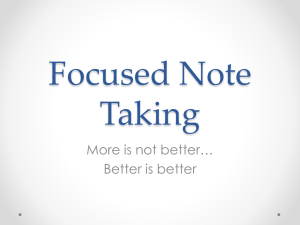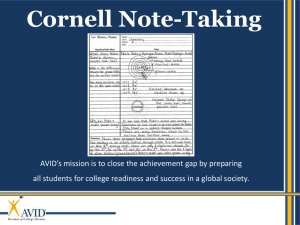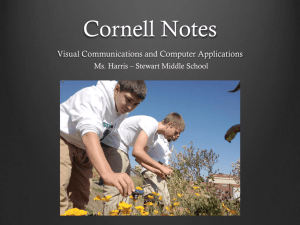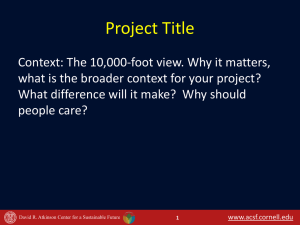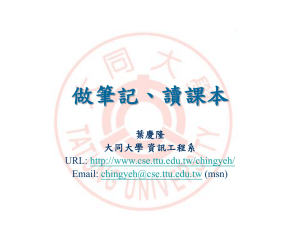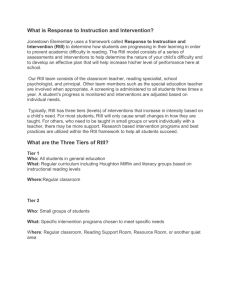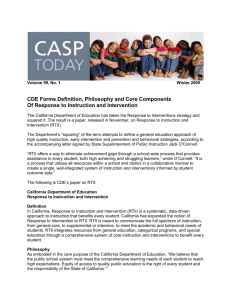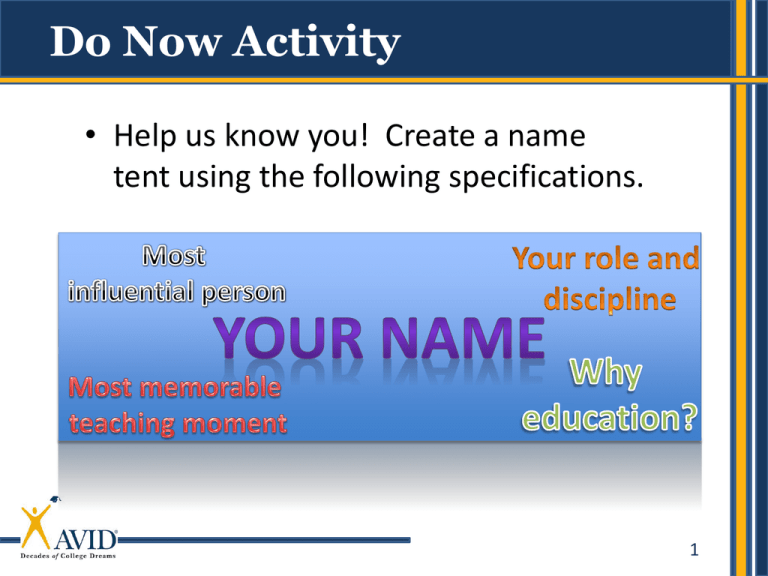
Do Now Activity
• Help us know you! Create a name
tent using the following specifications.
1
The CORNELL WAY and Utilizing
“Focused Note-Taking”
AVID’s mission is to close the achievement gap by preparing
all students for college readiness and success in a global society.
Presented by:
Kelly Smith - Instructional Specialist, GEAR UP
2
ksmith2@philasd.org
Norms
Ask questions.
Engage fully.
Integrate new information.
Open your mind to diverse views.
Utilize what you learn.
Used with permission of Learning Forward, www.learningforward.org.
All rights reserved.
3
Objectives
Each teacher will be able to:
• Support students with the foundational steps
of the CORNELL WAY to promote effective
note-taking skills.
• Differentiate the difference between
summary and reflection in the CORNELL
note taking strategy.
4
Schoolwide AVID OVERVIEW
AVID is schoolwide when a strong AVID
implementation transforms a school’s
LEADERSHIP,
SYSTEMS,
INSTRUCTION,
and CULTURE,
ensuring college readiness for all
students.
5
Agenda
Modeling CORNELL WAY:
–Note-Taking
–Note-Making
–Note-Interacting
–Note-Reflecting
6
Cornell
Notes
Quickwrite:
• Note-Taking When and how did you
• Note-Making
learn
to take effective notes?
• Note-Interacting
• Note-Reflecting
7
Essential Question
How can all teachers support the
use of Cornell note-taking and
teach the Cornell note-taking
process to our students?
8
Focused Note-Taking
CORNELL NOTE-TAKING SYSTEM
NOTE-TAKING
STEP 1
Create Format
STEP 2
Organize Notes
NOTE-MAKING
NOTEINTERACTING
STEP 3
Review & Revise
Notes
STEP 6
Link Learning to
Create a
Synthesized
Summary
STEP 4
Note Key Ideas to
Create Questions
STEP 7
Use Completed
Cornell Notes as a
Learning Tool
STEP 5
Exchange Ideas by
Collaboration
NOTEREFLECTING
STEP 8
Written Feedback
Walk through steps
in the folder
STEP 9
Address Written
Feedback
STEP 10
Your Reflection
9
There are many ways to take notes. You should learn
several strategies. Different learning situations may call
for different strategies.
• Sometimes you take notes while listening to
your teacher in class.
• Sometimes you take notes while you read (a
textbook, a novel, an article, a poem, etc.)
• Sometimes you take notes when watching a
film, TV, or a PowerPoint presentation.
10
Overview of Cornell Notes:
• http://www.youtube.com/watch?v=8t
_Vzeq5L3g
Walk through steps
in the folder
11
Cornell Notes Template:
Walk through steps
in the folder
12
The Cornell Way – Steps 1-6
Walk through steps
in the folder
13
Explanation of How to Use:
• http://www.youtube.com/watch?v=W
tW9IyE04OQ
14
7 – Learning Tool
What can we do to
ensure students use
their notes as a
learning tool?
15
Revisiting the Essential Question
How can all teachers support the
use of Cornell note-taking and
teach the Cornell note-taking
process to our students?
16
Rigorous Summaries
AVID’s mission is to close the achievement gap by preparing
all students for college readiness and success in a global society.
17
Objective
• Differentiate between the characteristics of
summaries and reflections
18
Essential Question
On your Cornell Note Paper:
What strategies are available to
teach students summarization,
and how will you use them in your
lessons?
19
Define Summary
Define
“Summary” as
Individuals
Share Your
“Summary
Definition”
with Your Table
Group
The Table –
Share Out!
20
Define Reflection
Create a
Definition for
“Reflection” as
an Individual
Share your
“Reflection”
Definition
with Your
Table Group
As A Table
Group,
SHARE OUT
Consensus on
the Definition
of
“Reflection”
21
Summary
• “Identifying and
accounting for essential
information
• Short descriptions of
something said or done
• Used to demonstrate
comprehension of
something written or
spoken.”
22
Reflection
Using Personal Connections to Improving the
Understanding of:
• Information
• Ideas and Stories
• Growth of the Learner
23
Venn Diagram
24
Summary v. Reflection
25
Cornell Note Summary Template
26
Let’s Review:
Reflection – On Your Cornell Notes – Share Out
3 - Things you learned 2 - pieces of insight, 1 – questions you still have
AVID’s mission is to close the achievement gap by preparing
all students for college readiness and success in a global society.
27
10 Minutes
28
Presented by:
Kelly Ann Smith - Instructional Specialist GEAR Up,
Ksmith2@philasd.org
School District of Philadelphia
Objectives:
• Teachers will have clarity about the key components
of the RtII Process.
• Participants will leave this session with specific tools
and where to find documents that are necessary to
help RtII implementation.
30
RtII Overview
• Proactive Student Support Process for General
Education Students
– Identify
– Address
– Monitor
– Revisit
31
RtII & Effectiveness
Principal Effectiveness
Domain 1: Strategic/Cultural Leadership
– 1c: Builds a Collaborative & Empowering Work
Environment
– 1d: Leads Change Efforts for Continuous Improvement
Domain 2: Systems Leadership
– 2d: Establishes and Implements Expectations for
Students & Staff
– 2e: Communicates Effectively and Strategically
32
RtII & Effectiveness
Teacher Effectiveness
Domain 1: Planning and Preparation
– 1b: Demonstrating Knowledge of Students
– 1c: Setting Instructional Outcomes
– 1d: Demonstrating Knowledge of Resources
Domain 2: The Classroom Environment
– 2b: Establishing a Culture for Learning
Domain 4: Professional Responsibilities
– 4d: Participating in a Professional Community
– 4f: Showing Professionalism
33
RtII: What’s New 2013-2014
•Math will be added
•BHS will include the following:
–Attendance (Days Absent)
–Behavioral/Mental Health / SAP (BHS)
–Student Discipline (Suspension)
–Interventions address Root Cause
34
SY 2012 VS. SY 2013
BHS
Literacy
• BHS
• Attendance
• Student
Discipline
Math
35
RtII Academic Levels
Level 1:
Classroom Instruction / Effective Teaching
(All Students)
Level 2:
Additional Intervention (~15% of Students)
Level 3:
Intensive Intervention (~5% of Students)
Levels 2 and 3 are in conjunction with Level 1
instruction.
36
RTII
Intensive
Targeted
Universal
Few
Continuum of
Support for ALL
Some
All
37
Designing School-Wide Strategies
Non-Instructional Support
Framework
Intensive, Individual Interventions
Level 3
•Individual Students
•Assessment-based
•Intense durable procedures
≈5%
Targeted Group Interventions
Level 2
•Some students (at-risk)
•High efficiency
•Rapid response
≈15%
≈85%
Universal Interventions
Level 1
•All settings, all students
•Preventive, proactive
The School District of Philadelphia
38
Where can you find Resources?
39
40
41
42
43
• Prevention: How can we avoid the problem?
• Teaching: How can we define, teach, and
monitor what we want?
• Recognition: How can we build in systematic
rewards for desired behavior?
• Consequences: What are efficient, consistent
hierarchal consequences for problem behavior?
44
• Office disciplinary referrals/pink slips
• Suspensions
• Serious incidents
Let’s Look at
Some
Handouts!
• Attendance
– Average Daily Attendance (ADA)
– Lateness
– Class cuts
45
Data Gathering
• Examine EWI report
–
–
–
–
–
Report card grades
Attendance
Keystone Exam results
Suspensions
SPED / ELLs
• Identify / Create a preliminary list of student
to monitor closely during the beginning of the
school year for remediation and enrichment
46
Record Data:
• Paper Documents
• Online – Schoolnet -STEPPER(Donna Sharer)
• Log In -
47
Tier 1 Intervention Monitoring
Form:
48
Possible Interventions/Strategies:
• Philasd.org - Toolkit – Curriculum Resources
• Holt Online Resources
49
Vocabulary Strategies:
•
•
•
•
Frayer – model
S.T.A.R.
Scattergories
Pictionary
50
Reading Comprehension
Strategies
• Read and Think Alouds
• Graphic Organizers
• Cornell Note Taking
• Reciprocal Teaching
51
Math Strategies
• CRA:
Concrete – Representational - Abstract
• Math Manipulatives
• Acronyms
• Language Rich Classroom
52
Writing Strategies
• Show Don’t Tell
• Sentence Starters
• Guided Writing
53
What are some strategies and
Interventions you are already using?
54
Thank You for Being an Amazing
Audience!!!
55

